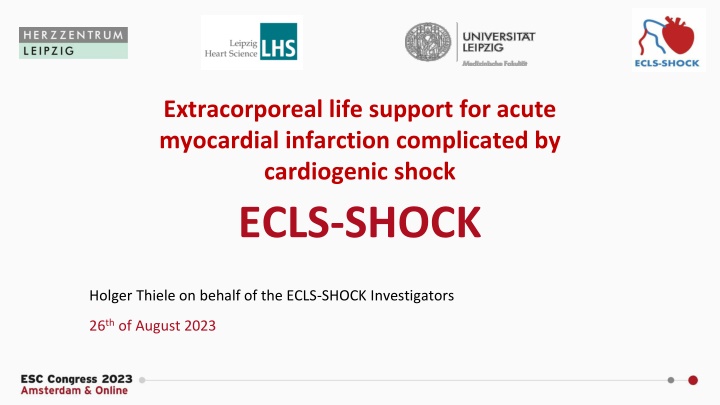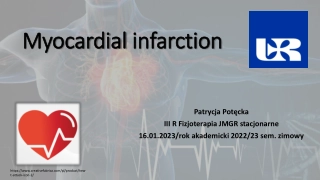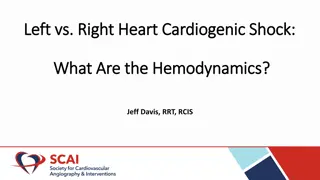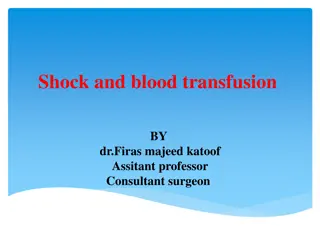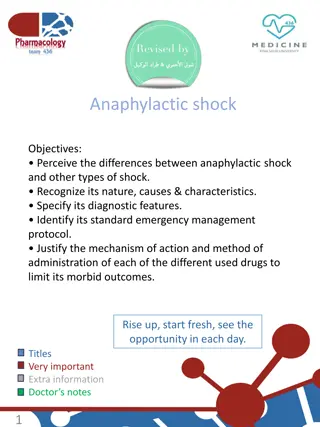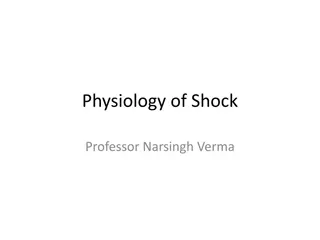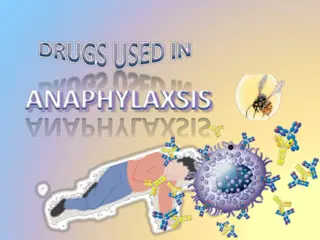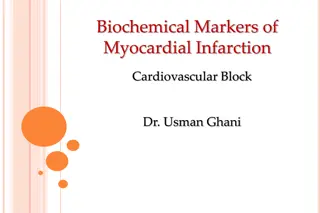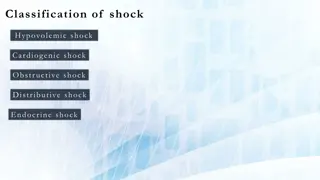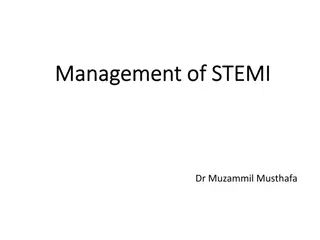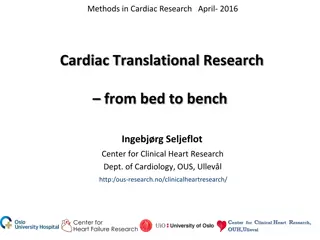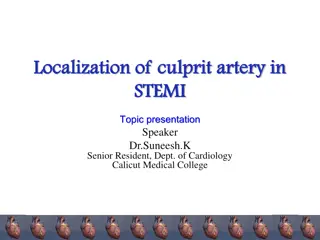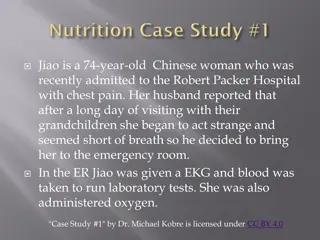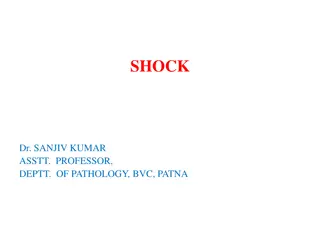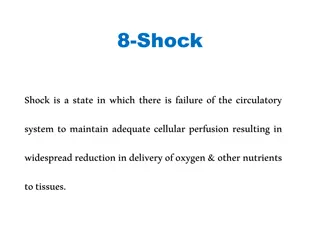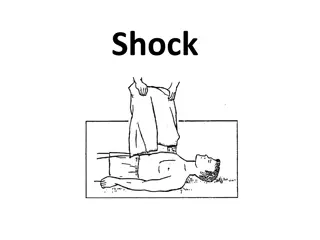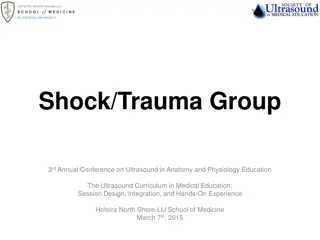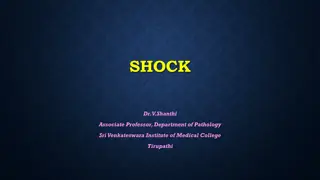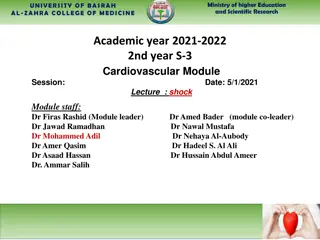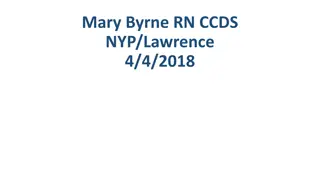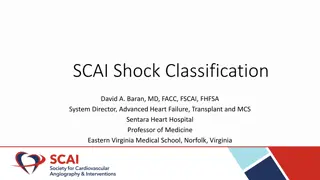Extracorporeal Life Support for Acute Myocardial Infarction Complicated by Cardiogenic Shock
This study explores the use of extracorporeal life support (ECLS) in patients with acute myocardial infarction complicated by cardiogenic shock. The researchers investigate the impact of ECLS on mortality and various secondary endpoints such as renal failure, recurrent infarction, and need for revascularization. The methodology includes detailed statistical analysis and aims to enroll 420 patients to assess outcomes.
Download Presentation

Please find below an Image/Link to download the presentation.
The content on the website is provided AS IS for your information and personal use only. It may not be sold, licensed, or shared on other websites without obtaining consent from the author.If you encounter any issues during the download, it is possible that the publisher has removed the file from their server.
You are allowed to download the files provided on this website for personal or commercial use, subject to the condition that they are used lawfully. All files are the property of their respective owners.
The content on the website is provided AS IS for your information and personal use only. It may not be sold, licensed, or shared on other websites without obtaining consent from the author.
E N D
Presentation Transcript
Extracorporeal life support for acute myocardial infarction complicated by cardiogenic shock ECLS-SHOCK Holger Thiele on behalf of the ECLS-SHOCK Investigators 26thof August 2023
Conflict of Interest Statement Funding: German Research Foundation German Heart Research Foundation German Cardiac Society European Union Else-Kr ner-Fresenius-Foundation Schwiete-Foundation Boston Scientific Consulting: None Speaker Honoraria: None
Background Cardiogenic Shock - Mortality over Time SHOCK Trial SHOCK Trial CULRPIT- IABP-SHOCK II TRIUMPH Trial Trial Multivessel PCI Culprit only Adapted from Werdan et al. Eur Heart J 2014;35:156-167
Background Currently Available MCS 2.5 CP 5.0 5.5 5 Thiele et al. Eur Heart J 2019:40:2671-2683 Byrne/Ibanez et al. Eur Heart J 2023;epub
Background Increase in VA-ECMO (ECLS) Over Time IABP-SHOCK II Trial Karagiannidis et al. Intensive Care Med.2016;42:889 896 Becher et al. Circulation 2018;138:2298-2300
Methods Endpoints/Statistical Methodology Primary endpoint Sample size 30-day all-cause mortality Estimated event rate for primary endpoint: 49% in control group versus 35% in ECLS group Secondary endpoints Acute renal failure requiring renal replacement therapy within 30 days Recurrent myocardial infarction within 30 days Need for repeat revascularization (PCI and/or CABG) within 30-days Rehospitalization for heart failure within 30 days Cerebral performance category (CPC) at 30 days Time to hemodynamic stabilization 1 interim analysis (50% of patients) Duration of catecholamine therapy Serial creatinine-level and creatinine-clearance until hemodynamic stabilization Mean and area under the curve of arterial lactate during 48 hours after PCI Peak release of myocardial enzymes Serial SAPS II Length of mechanical ventilation Length of ICU stay Length of hospital stay 2-sided Chi2-test; power: 80%, alpha=0.048 for final analysis 390 patients To compensate for losses in follow-up 420 patients Thiele et al. Am Heart J 2021;234: 1-1
Methods In- and Exclusion Criteria Inclusion Criteria Exclusion Criteria Cardiogenic shock complicating AMI (STEMI or NSTEMI) plus obligatory: Resuscitation >45 minutes Mechanical cause of cardiogenic shock Onset of shock >12 h Severe peripheral artery disease with impossibility to insert ECLS cannulae Age <18 years or >80 years Shock of other cause (bradycardia, sepsis, hypovolemia, etc.) Other severe concomitant disease with limited life expectancy <6 months Pregnancy Participation in another trial 1. Planned revascularization 2. SBP <90 mmHg >30 min or catecholamines required to maintain SBP >90 mmHg 3. Signs of impaired organ perfusion with at least one of the following criteria: Altered mental status Cold, clammy skin and extremities Oliguria with urine output <30 ml/h 4. Arterial lactate >3 mmol/l Informed consent Thiele et al. Am Heart J 2021;234: 1-1
Results Trial Flow 44 study sites Thiele et al. Am Heart J 2021;234: 1-1
Results Baseline Characteristics ECLS (n=209) Control (n=208) Age (years); median (IQR) Male sex; n/total (%) Signs of impaired organ perfusion; n/total (%) Altered mental status Cold, clammy skin and extremities Oliguria Mean blood pressure (mmHg); median (IQR) STEMI; n/total (%) Resuscitation before randomization; n/total (%) No. of diseased vessels; n/total (%) 1 2 3 LVEF (%); median (IQR) Laboratory values on admission pH; median (IQR) Lactate (mmol/L); median (IQR) 62 (56 - 69) 170/209 (81.3) 63 (57 - 71) 169/208 (81.3) 200/209 (95.7) 202/209 (96.7) 150/209 (71.8) 71 (61 - 87) 135/204 (66.2) 162/209 (77.5) 198/208 (95.2) 204/208 (98.1) 150/208 (72.1) 72 (60 - 88) 141/207 (68.1) 162/208 (77.9) 71/203 (35.0) 71/203 (35.0) 61/203 (30.0) 30 (20 - 35) 63/200 (31.5) 53/200 (26.5) 84/200 (42.0) 30 (20 - 40) 7.2 (7.1 - 7.3) 6.8 (4.5 9.6) 7.2 (7.1 - 7.3) 6.9 (4.6 10.0)
Results Treatment ECLS (n=209) Control (n=208) Type of inital revascularization; n/total (%) PCI CABG PCI with emergent transfer to CABG ECLS therapy; n/total (%) Initiation in catheterization laboratory Prior revascularization During revascularization After revascularization Initiation after catheterization laboratory <24 hours 24 hours Duration of ECLS therapy (days); median (IQR) Peripheral antegrade perfusion sheath; n/total (%) Active left ventricular unloading in ECLS; n/total (%) Other MCS in patients without ECLS; n/total (%) Invasive mechanical ventilation; n/total (%) 199/208 (95.7) 1/208 (0.5) 2/208 (1.0) 192/209 (91.8) 199/204 (97.5) 0/204 0/204 26/208 (12.5) 42/192 (21.9) 50/192 (26.0) 100/192 (52.1) 4/26 (15.4) 8/26 (30.8) 7/26 (26.9) 0/192 0/192 3/26 (11.5) 4/26 (15.4) 2.7 (2.2 3.8) 16/19 (84.2) 6/19 (31.6) 28/182 (15.4) 177/202 (87.6) 2.7 (1.5 - 4.8) 183/192 (95.3) 11/191 (5.8) 0/17 183/203 (90.1)
Results Primary Endpoint 30-Day All-Cause Mortality 100 100 Patients Who Died from Any Cause Relative risk: 0.98 (95% CI 0.80-1.19) P=0.81 90 90 80 80 70 70 60 60 (%) 50 50 40 40 30 30 20 20 10 10 Control ECLS 0 0 0 0 5 5 10 10 15 15 20 20 25 25 30 30 Days since randomization No. at Risk 20 9 20 8 161 136 119 109 107 105 ECLS 146 120 109 105 104 100 Control
Results Key Secondary Endpoints Renal Function - eGFR Arterial Lactate SAPS-II
Results Safety RR 2.44 30% (95% CI 1.50-3.95) ECLS Control 25% 23.4% 20% RR 2.86 (95% CI 1.31-6.25) 15% RR 1.33 11.0% 9.6% 10% (95% CI 0.47-3.76) 3.8% 3.8% 5% 2.9% 0% Stroke Moderate/severe bleeding (BARC 3-5) Peripheral ischemic vascular complication requiring surgical or interventional therapy
Results 30-Day All-Cause Mortality - Subgroups
Results IPD Meta-Analysis VA-ECMO vs No VA-ECMO
Results IPD Metaanalysis 30-Day All-Cause Mortality
Results IPD Metaanalysis 30-Day Mortality - Subgroups
Summary and Conclusions In patients with acute myocardial infarction and cardiogenic shock with planned revascularization ECLS (VA-ECMO) versus control does not reduce 30-day all- cause mortality. This lack of mortality benefit is supported by an IPD metaanalysis of all 4 RCTs comparing ECLS vs control. This lack of mortality benefit is further supported by the fact that there were no differences in the secondary endpoints (e.g. lactate, renal function, duration of catecholamines, etc.). ECLS is associated with higher rates of moderate or severe BARC bleeding and peripheral ischemic complications requiring intervention. The findings challenge current guideline recommendations and clinical practice with increasing rates of mechanical circulatory support in cardiogenic shock.
Acknowledgments and Thank You Our greatest thanks go to the patients and relatives. @thiele_holger holger.thiele@medizin.uni-leipzig.de
www.thelancet.com www.nejm.org
